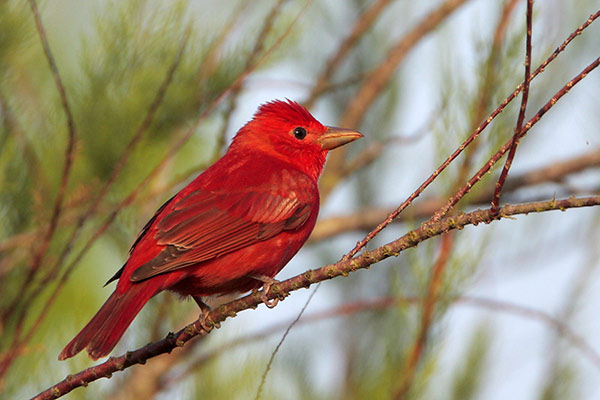Summer Tanagers (Piranga rubra) are vibrant red or yellowish-green birds found throughout the open woodlands of the southern and eastern regions of the United States.
Despite their bold coloring, Summer Tanagers are often difficult to spot due to their tendency to inhabit the canopy of trees.
These songbirds specialize in hunting wasps and bees, so keep an eye out to see them in action!
On this page
Identification
Summer Tanagers are medium-sized songbirds with large and thick bills, a slender build, and a large head. They measure 7-8 inches long, weigh around an ounce, and their wingspan is 11-12 inches. There are two recognized Summer Tanager subspecies.
The one that breeds in the southwestern United States has paler plumage, and the one that breeds in the eastern part of the range has shorter legs, wings, and tails.
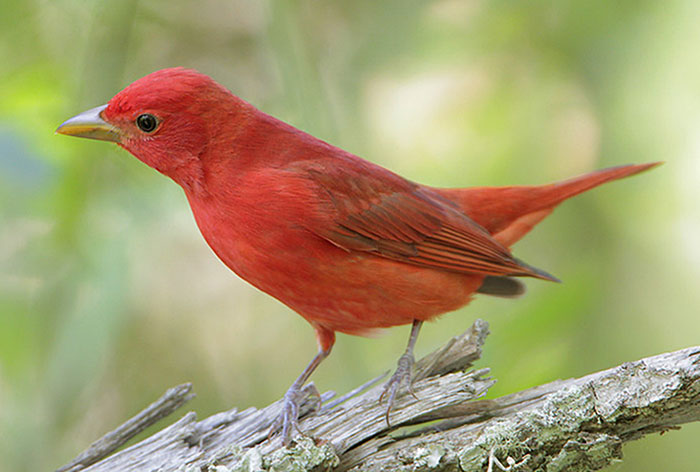
Male Summer Tanager
Adult male Summer Tanagers have an overall vibrant crimson-red plumage with a tinge of black to their primary flight feathers and a dark wash on their wings and tail tip. However, they usually appear uniformly red.
Adult female Summer Tanagers have mustard-yellow plumage. If you look a bit closer, you can see that their backs are slightly olive-toned whereas their undersides and heads are yellower. Their wings appear a bit darker, similar to the males. Both sexes have dark legs, black eyes, and may have a slightly crested head at times.
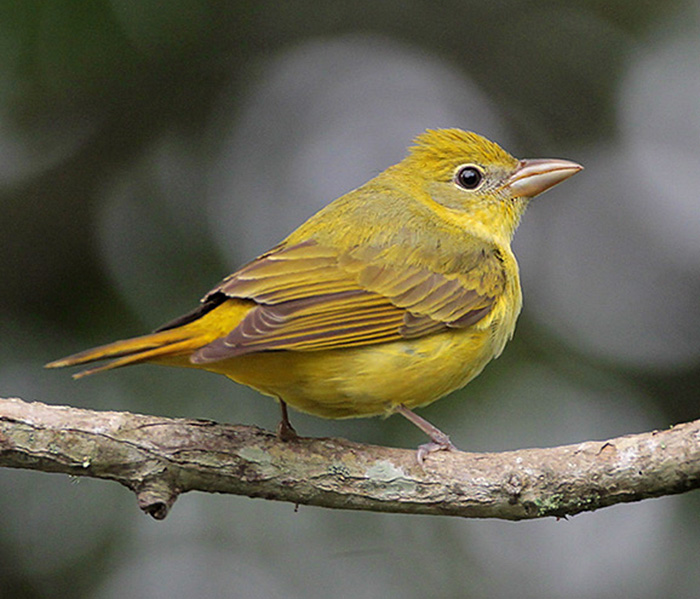
Female Summer Tanager
Juvenile Summer Tanagers look similar to females. However, as the males mature, they develop blotchy yellow and red plumage before they acquire their red adult plumage.
Summer Tanager’s song is a series of sweet, slurred whistles that last for a few seconds. Their usual calls are clicking pi-tuk, pik-i-tuk-i-tuk, or other variations of these syllables. They also use scolding sounds and one-noted chips.
Food
Summer Tanager’s diet consists of insects and small fruit and berries. During the summer, they primarily feed on insects, mainly bees and wasps, but also other terrestrial and aerial invertebrates.
That includes beetles, cicadas, caterpillars, grasshoppers, flies, dragonflies, grubs, ants, moths, spiders, and others.
As the breeding season comes to an end and during migration and winter, they will also eat small fruits and berries, including blackberries, mulberries, bananas, pokeweed, and citruses.
Summer Tanagers mostly forage in treetops. They snatch insects from leaves and bark, hover or perch to pluck berries and fruit, and fly out and capture aerial insects mid-air.
When the bird has caught an insect, it will bring its prey back to a perch and smack it into the perch until it dies. If it’s a wasp or a bee, they will wipe it against a branch to remove the stinger.
Summer Tanagers also break into wasp’s nests to eat their larvae.
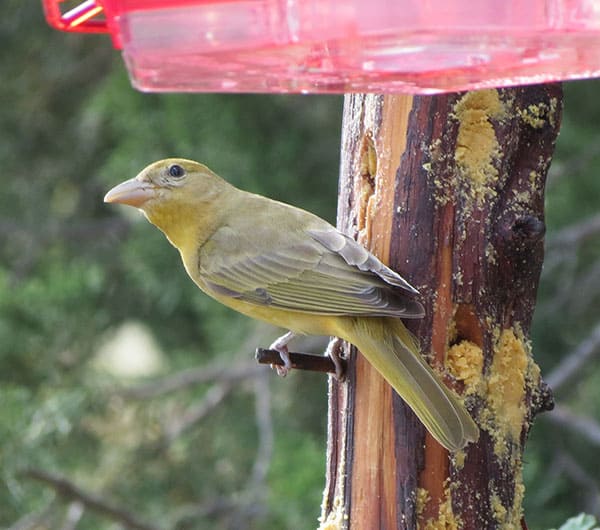
Nesting and Eggs
These birds are serially monogamous, which means that they pair-bond for a breeding season and raise the young together. Males sing to establish and defend their nesting territory and chase females, sometimes offering them food.
Summer Tanagers nest 10-35 feet above the ground on a horizontal branch away from the trunk in a cluster of leaves or a fork of branches. The female is in charge of gathering material and building the nest.
The completed nest is a shallow cup made of grasses, bark strips, leaves, fine grass, and other dry and fine plant material measuring 3.5 inches across and 2 inches high.
The quality of the nest varies, with the nests in the western part of the range being sturdy and the nests in the eastern part of the range being on the flimsier side.
Summer Tanagers lay 3-4 eggs in a clutch that are pale blue or green with brown markings and about an inch long and 0.6-0.7 inches wide. The female incubates the eggs by herself for 11-12 days and the male may feed her.
The young leave the nest after about 8-10 days and reach independence 2-4 weeks after fledging. During that time, the parents will feed and take care of them.
Current Situation
Summer Tanagers range throughout the southern, eastern, and southwestern United States with some of its range extending as far as Iowa. They’re migratory birds and fly to Central America and northern South America for the winter.
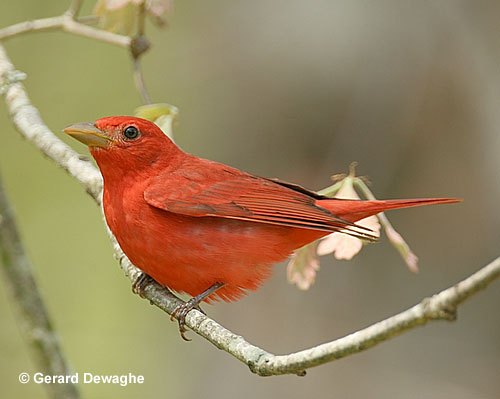
These birds prefer open wooded areas, especially with oak trees. During the summer, they can be found in different deciduous and mixed open woodlands, sometimes also in orchards and parks.
In the Southwest, they breed along streams in cottonwood-willow forests whereas in the Southeast, they breed in open woods with oak, pine, or hickory. They fly south for the winter and may be seen in open and second-growth woodlands, forests, along its edges, in clearings, and up to middle elevations in mountains.
Summer Tanagers are listed as species of least concern on the IUCN Red List, and their population in North America has remained stable. Threats to this species include the destruction of habitat.
Facts
- Summer Tanagers’ favorite foods are wasps and bees. They frequently attack wasp nests to scare them away and then eat the larvae left behind. When they catch a wasp or a bee, they first smash them into a perch to kill them and then wipe it along the perch to remove stingers and other indigestible body parts.
- Contrary to the name, Summer Tanagers do not belong to the tanager family (Thraupidae). Instead, they are a part of the cardinal family (Cardinalidae).
- Summer Tanagers symbolize patience, joy, faithfulness, brightness, warmth, and positivity.
- One of the most popular red birds with Northern Cardinal.
- Albeit very rare, there have been instances where the Summer Tanager has hybridized with other tanager species. One of those is the hybrid of a Summer and a Western Tanager discovered in 2006. The hybrid had an overall orange plumage and a dark wash on its wings and tail.
- If you want to attract Summer Tanagers to your backyard, grow plants that attract their preferred insects and produce their favorite berries and fruit. These include blackberries, bananas, citruses, pokeweed, and any other native flowers and plants bees would choose.
Similar Species
Summer Tanagers are beautiful birds with an overall red plumage with a few similar species. We have introduced four of them and brought out their main differences.
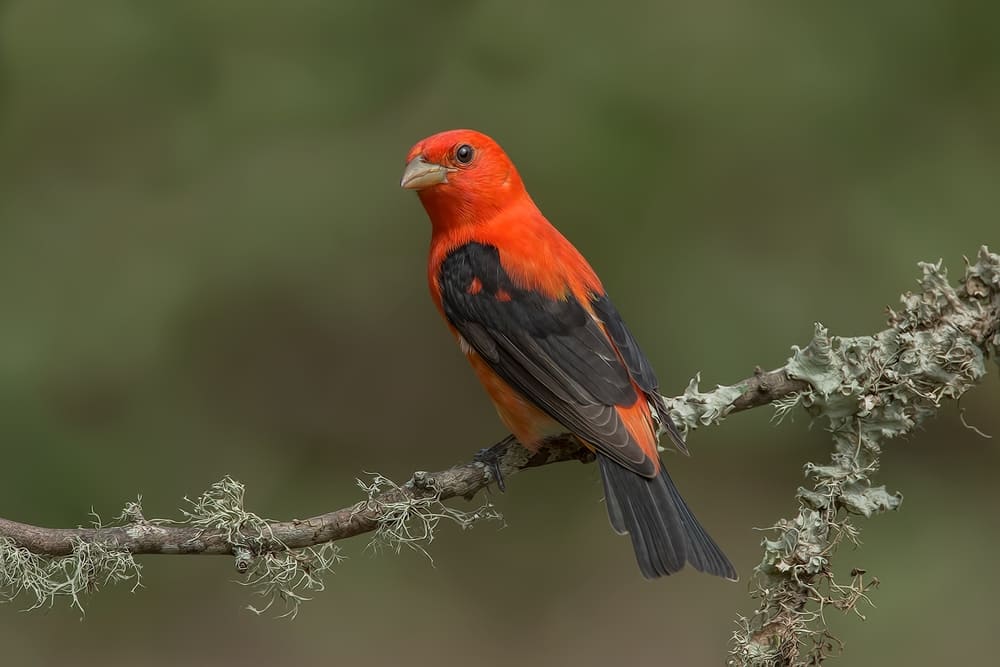
Scarlet Tanager
Adult males of both species have an overall vibrant red plumage. However, Scarlet Tanagers have black wings, whereas Summer Tanagers only have a blackish tinge to them.
Females are harder to distinguish. Their wings are a key indicator. Female Summer Tanagers have yellowish-orangish wings, whereas female Scarlet Tanagers have darker blackish wings.
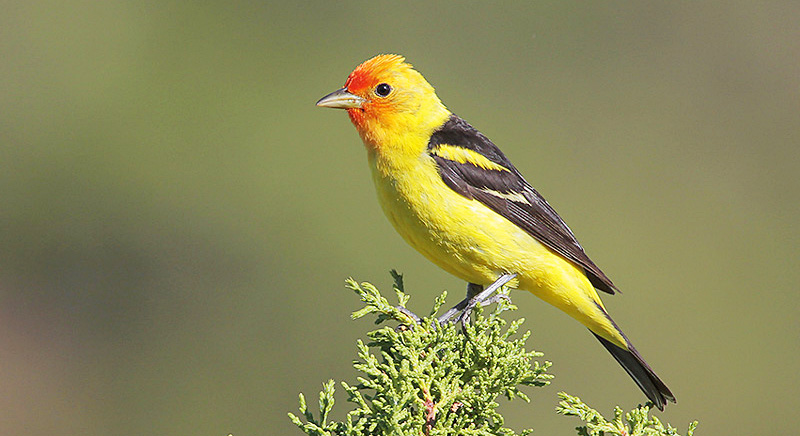
Western Tanager
Female Western and female Summer Tanagers look fairly similar with their overall yellowish-greenish plumage. However, female Western Tanagers have blackish wings with pale wingbars, whereas Summer Tanagers have yellowish-orange wings without wingbars.
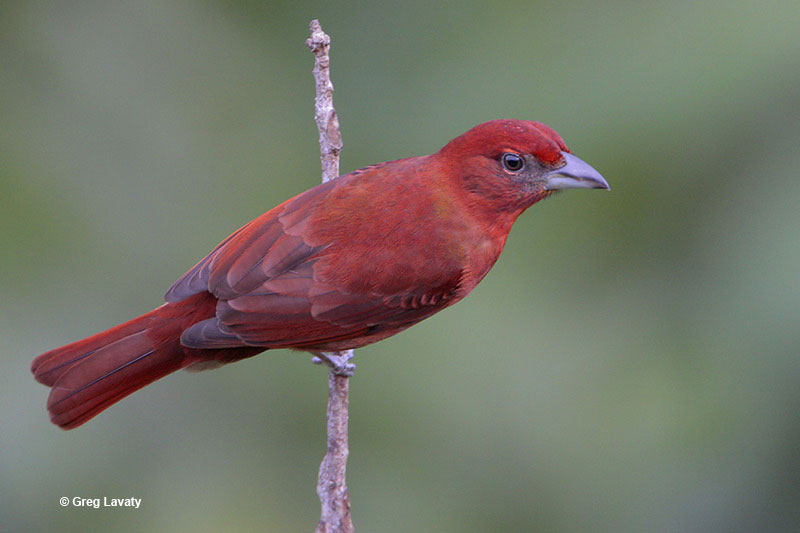
Hepatic Tanager
Males from both species have an overall red plumage. However, male Hepatic Tanagers have grayish cheek patches, and their backs also have a grayish tinge to them.
Females are very similar, but Summer Tanagers have brighter plumage and a dark bill, whereas female Hepatic Tanagers have a grayish shade to their plumage and a pinkish bill.
Frequently Asked Questions
What is the difference between a Scarlet Tanager and a Summer Tanager?
Male Summer Tanagers are bright red overall, whereas male Scarlet Tanagers have red plumage but black wings and tails. Females are rather similar, but Scarlet Tanagers have darker and blackish wings.
Is it rare to see a Summer Tanager?
Summer Tanagers are fairly common in the United States during the summer. However, despite their vibrant red plumage, they can be quite difficult to spot because they mostly forage high in trees concealed by foliage.
Where do Summer Tanagers live?
Summer Tanagers live in open woodlands in the eastern, southwestern, and southern United States.
Where do Summer Tanagers nest?
Summer Tanagers nest 10-35 feet above the ground in a tree, most often an oak or a pine. The nest is built on a horizontal branch and away from the trunk, usually in a cluster of leaves or a fork of branches.

